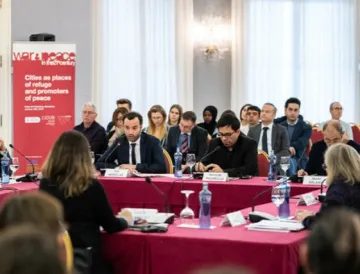War and Peace in the 21st Century 2019: Cities as places of refuge and promoters of peace

To fully grasp the dynamics of today’s internationals relations we need to look beyond the actions and policies of nation states and international organizations, to also consider sub-national governments and non-state actors.
The 17th edition of War and Peace in the 21st Century examined the role of “Cities as Places of Refuge and Promoters of Peace” in the context of growing international migration flows caused by conflict, oppression, poverty and climate change, as well as profound transformations in world politics with cities and city governments emerging as increasingly influential actors. The conference was organized by CIDOB and Barcelona City Council, in collaboration with ESADEgeo Centre for Global Economy and Politics and supported by “la Caixa” Foundation.
Focusing on governance approaches and solutions, the conference addressed two key questions. Firstly, how cities can deal with the consequences of violent conflict and refugees, and, secondly, how cities can help to prevent conflict and become drivers of peace. The debate that brought together esteemed experts, policy makers and practitioners from Belgium, Chile, Colombia, New Zeeland, Turkey, the United Kingdom and United States highlighted a number of key issues and questions.
Cities: the villains or heroes of conflict?
As Jo Beall, Research Professor at the LSE Cities Programme and former Deputy Vice Chancellor of the University of Cape Town, stressed, cities need to be viewed in their specific contexts. Their role as havens of peace (e.g. Goma and Kinshasa during the war in the Democratic Republic of Congo), arenas of conflict (e.g. Aleppo in the Syrian war) or targets of “spectacular violence” (Daniel Goldstein) (e.g. New York City during the 9/11 attacks) largely depends on whether they are involved in, or managing the repercussions of local, national or international conflict.
Enabling cities as mitigating forces and global political actors
For Juliana Kerr, Director of Global Cities and Immigration at The Chicago Council on Global Affairs, the urgent need to adjust the system of global governance to the realities of our urban age became particularly evident during the adoption process of the UN Global Compact for Migration in Marrakesh in December 2018. Although cities are at the front lines of receiving and hosting refugees and migrants and carry out the large share of service provisions, they only had a minor consultative role in the process.
Addressing this problem in the context of climate governance, Helen Clark, former Prime Minister of New Zeeland and former Administrator of the UN Development Programme (UNDP), argued that effective global and national climate action depends on the involvement of and collaboration with cities. While cities play the dual role of concentrating pollution and driving technological, infrastructural and social solutions to the problem, they will also be the principal bearers of climate migration.
Cities as problem solvers: fostering solidarity and inclusion
Gaziantep, in Turkey’s south-eastern Anatolia region, is one of the world´s cities with the highest share of refugee population. 600,000 of the 2 million inhabitants are Syrian refugees. The city’s Deputy Mayor, Latif Karadağ, explained how the local administration has been able to effectively manage the situation by resorting to an integrational approach that invests in co-habitation (less than 8% of the refugees live in camps), community centres, vocational training, and language classes.
The city of Vilvoorde in the vicinity of Brussels is a hyper-diverse city with no dominant ethnic group, culture or religion. One of Europe´s principal breeding grounds for jihadist fighters until 2013, the city formulated a highly effective de-radicalization strategy that, as Mayor Hans Bonte layed out, prioritizes socially pro-active prevention over repression and security.
Like earlier work done in Medellin around gang violence and drug crime, presented by Jorge Melguizo, former Secretary of Culture of Medellin, the “Vilvoorde method” proves that by mobilizing civil society and engaging volatile and high-risk groups in the local community –thereby creating a sense of belonging, value and responsibility– city governments can effectively prevent and counter conflict and violence.
Rewriting populist migration narratives
A final pressing question that stood at the centre of the debate was how cities can change contemporary populist narratives that portray migrants and refugees as causing violence and conflict. Referring to the rising number of “sanctuary cities” in the United States, Juliana Kerr highlighted how mayors have been at the forefront of countering President Trump´s anti-immigration and deportation agenda, which recently culminated in his televised “Address to the Nation on the Crisis at the Border”.
A research agenda for global cities
The discussion of the role of cities in conflict resolution and prevention, and as actors managing global challenges on the ground, raised broader questions about their role in national and international governance. In his concluding remarks Pol Morillas, director of CIDOB, stressed that cities are decreasingly mere implementers of national and global agendas but, as the sphere of government closest to inhabitants, they bring new political concerns to the table. Complementing the perspective and competences of states, with their focus on macro issues around geostrategic control, security and competition over global resources and trade, cities put forth a more human-centred perspective that is concerned with the organisation of human settlements and the coexistence of people in a territory.
>> War and Peace in the 21st Century 2019 Conference Report
>> Photo Gallery War and Peace in the 21st Century 2019: Cities as places of refuge and promoters of peace